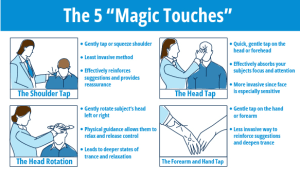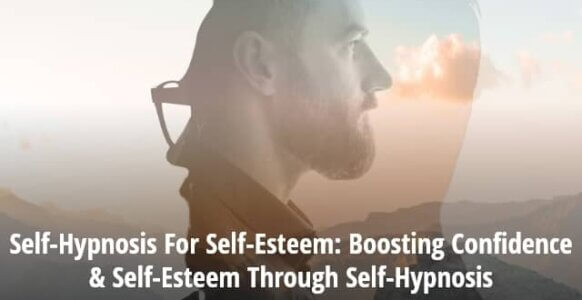
How do you effectively guide someone into a state of deep trance?
Although hypnotic language often steals the spotlight, when used correctly physical touch can be just as effective.
Using the right kind of “hypnotic touches” creates a space of trust, support, safety and relaxation. What’s more, this gentle form of contact helps make your subject feel comfortable enough to enter deeper states of hypnosis.
And as any hypnotist will tell you, a relaxed state of mind and deep relaxation are essential to making someone more receptive to hypnotic suggestions that can lead to healing and transformation.
So keep reading to find out how hypnotic touch facilitates deeper trance states, along with “5 magic touches” you can start using in your own hypnosis practice for better results.
How Hypnotic Touch Increases Relaxation, Focus and Trance
To be able to hypnotize someone, you first need to absorb their attention.
There are many ways to do this, and one of the most effective techniques is using hypnotic touch paired with hypnotic suggestions.
Hypnotic touches create an instant pathway for the mind to narrow its attention. As you direct all awareness to the sensation of touch and the sound of the hypnotist’s voice, distractions begin to fade away and the mind’s focus sharpens.
This dual engagement of the tactile and the auditory senses makes the transition into a deep trance state smoother and more seamless.
Ethical considerations when using hypnotic touch
Of course it’s important to mention that the use of touch in hypnosis must be approached with professionalism and consent. Explicit permission should be obtained from your subject before integrating touch into the session. This ensures that the experience remains positive, ethical, and beneficial.
Now that you know why hypnotic touch is such a powerful tool, you can move onto discovering specific techniques to incorporate into your hypnosis sessions.
The 5 “Magic Touches”
If you’re new to using physical touch as a way to deepen trance, a good place to start is with the “5 magic touches”. Each one of these 5 touches targets a specific aspect of the hypnotic process, from induction to deepening.
Where you decide to apply the hypnotic touches will depend on your level of comfort and trust with the subject and explicit permission is advised for all five.
Here’s a breakdown of how and when to use each one:
The Shoulder Tap
This type of hypnotic touch is considered to be the least invasive method, and a good starting place if you’re working with a new subject.
Gently tapping or squeezing your subject on the shoulder serves as an effective way to reinforce a suggestion. It provides reassurance that allows the subject to feel safe and supported, deepening their comfort and openness to the hypnotic process.
The Head Rotation
This technique gently rotates the head to help the subject relax further into trance. The physical guidance helps signal to the brain that it’s safe to release control and surrender to the unfolding hypnotic process.
As a result, your subject will go into a deeper state of trance and relaxation.
The Head Tap
The head tap is a quick, gentle tap on the head that can surprise and therefore heighten the subject’s focus on a suggestion.
However, since the head, face and neck are sensitive areas this method should be approached with extra caution. Make sure you’ve established deep rapport with your subject, and gained permission before trying out this approach.
The Forearm and Hand Tap
In a similar way, you can also tap your subject gently on the forearm or hand as you offer a suggestion. This will allow your words to absorb deeper into your subject’s mind, all while enhancing the trance experience.
Demonstration of the 5 Magic Touches
Want to see the “5 magic touches” demonstrated by Master Hypnotist Igor Ledochowski?
You can watch the full video here:
Simply put, by combining hypnotic touches with suggestions, you’ll create the right conditions for your hypnosis subject to experience deeper trance, and experience profound insights, transformations and healing through hypnosis.
What could be better?
Bring Hypnosis to Life in Just 5 Minutes
You’ve discovered how hypnotic touch creates deep trance. Now, imagine handing that same experience directly to someone else.
In this FREE training, you’ll learn 9 “Hypnotic Gifts”—simple, five-minute hypnotic techniques that illustrate the power of hypnosis and help others access untapped resources within their mind.
It’s the perfect way to make hypnosis tangible, build trust, and inspire transformative experiences in just moments.









![[ADVANCED GUIDE] How To Master Hypnotic Regression Therapy - Part I: Essential Principles To Profoundly Transform Your Subject’s Emotional Trauma [ADVANCED GUIDE] How To Master Hypnotic Regression Therapy - Part I: Essential Principles To Profoundly Transform Your Subject’s Emotional Trauma](https://hypnosistrainingacademy.com/wp-content/uploads/2016/09/hypnotic-regression-therapy-essential-principles.jpg)



![Yogic Breathing For Hypnosis: 3 Easy Techniques To Ground & Relax Your Clients Before Inducing A Hypnotic Trance [Includes Infographic] Yogic Breathing For Hypnosis: 3 Easy Techniques To Ground & Relax Your Clients Before Inducing A Hypnotic Trance [Includes Infographic]](https://hypnosistrainingacademy.com/wp-content/uploads/2019/05/yogic-breathing-for-hypnosis.jpg)

